Missoula Area Attractions
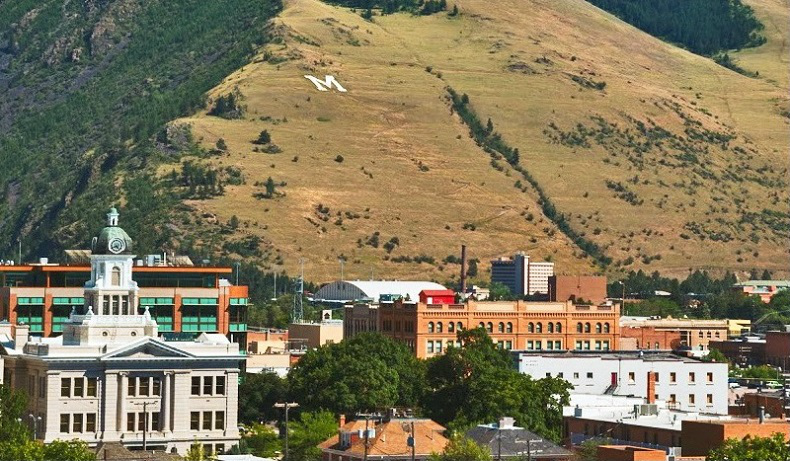
Missoula, Montana.
Missoula Area Attractions
"Hub of Five Valleys"
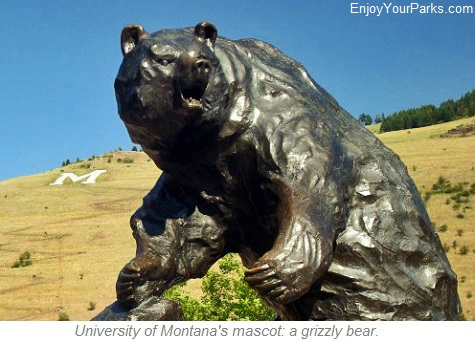 Missoula, Montana is Montana's second largest city, and is located in the heart of Western Montana and close to many major Montana Attractions. Known as the "Hub of Five Valleys", Missoula rests in a broad valley along Interstate 90 and is surrounded by mountains and valleys, all providing fantastic outdoor recreational opportunities. Probably best known as the home to the University of Montana "Grizzlies", Missoula is also home to a charming downtown historic district with wonderful shops and restaurants. There are also several wonderful museums and the historic Fort Missoula. The fabled Clark Fork River runs directly through the town, where there is a fantastic walking/hiking trail along its banks that locals as well as visitors can thoroughly enjoy.
Missoula, Montana is Montana's second largest city, and is located in the heart of Western Montana and close to many major Montana Attractions. Known as the "Hub of Five Valleys", Missoula rests in a broad valley along Interstate 90 and is surrounded by mountains and valleys, all providing fantastic outdoor recreational opportunities. Probably best known as the home to the University of Montana "Grizzlies", Missoula is also home to a charming downtown historic district with wonderful shops and restaurants. There are also several wonderful museums and the historic Fort Missoula. The fabled Clark Fork River runs directly through the town, where there is a fantastic walking/hiking trail along its banks that locals as well as visitors can thoroughly enjoy.
Some of the nearby attractions include The Bitterroot Valley, National Bison Range, Fort Missoula, Lolo Pass, Seely-Swan Valley and Ovando Valley. And only 70 miles to the north along U.S. Highway 93 is the legendary Flathead Lake, the largest freshwater lake west of the Mississippi River. And just northeast of Flathead Lake is the world-renowned Glacier National Park, which is just 3 hours from Missoula. And by the way, Yellowstone National Park is 3 and a half hours from Missoula, making it the half-way point between these two iconic national parks. Nicknamed the "Garden City" because of its reasonably mild climate, Missoula is a gorgeous town nestled in the heart of Western Montana, and is well worth spending some time during your Montana vacation discovering and exploring the town and surrounding attractions.
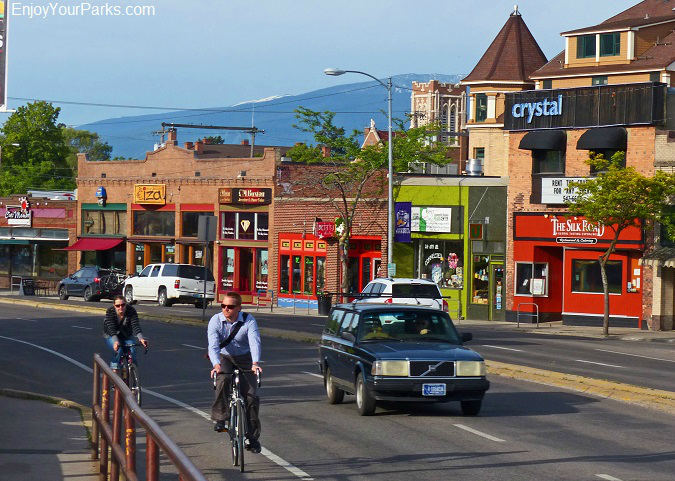
Missoula, Montana
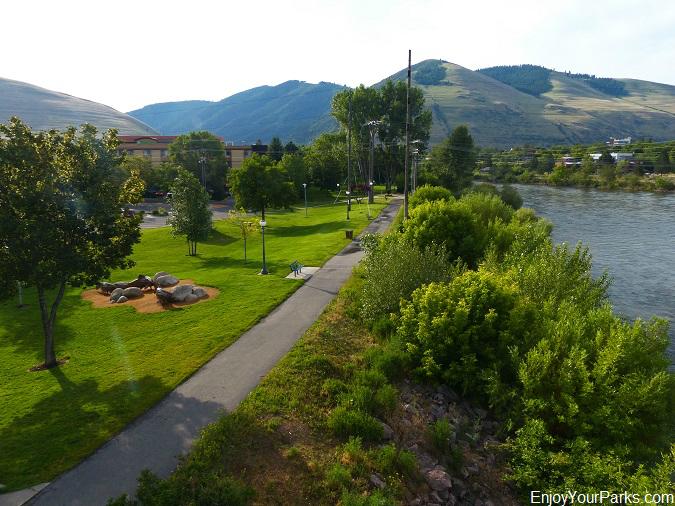
Walking/Biking Trail and the Clark Fork River running through the center of Missoula Montana.
Brief History
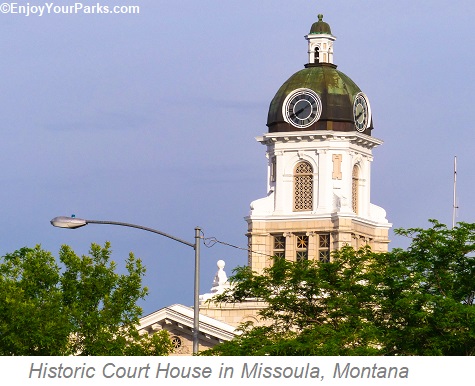 Lewis and Clark actually came through this valley in 1805, but the first establishment was founded in 1860, where Missoula was first part of the Washington Territory and was originally known as the Hellgate Trading Post. This important center of trade in the mid 1800s was moved 5 miles upstream and renamed Missoula Mills, where it provided supplies to pioneers traveling the Mullan Road. The name shortened to simply "Missoula", and in 1877, the establishment of Fort Missoula to protect settlers created an even more stable economy. Then in 1883 the Northern Pacific Railway brought extremely fast growth to its lumber industry. Ten years later, in 1893, the state's first university was established here. Another boost to the local economy was when the U.S. Forest Service founded it's headquarters in Missoula in 1908. All of these factors built the economy of the valley and resulted in the town of Missoula that we are familiar with today.
Lewis and Clark actually came through this valley in 1805, but the first establishment was founded in 1860, where Missoula was first part of the Washington Territory and was originally known as the Hellgate Trading Post. This important center of trade in the mid 1800s was moved 5 miles upstream and renamed Missoula Mills, where it provided supplies to pioneers traveling the Mullan Road. The name shortened to simply "Missoula", and in 1877, the establishment of Fort Missoula to protect settlers created an even more stable economy. Then in 1883 the Northern Pacific Railway brought extremely fast growth to its lumber industry. Ten years later, in 1893, the state's first university was established here. Another boost to the local economy was when the U.S. Forest Service founded it's headquarters in Missoula in 1908. All of these factors built the economy of the valley and resulted in the town of Missoula that we are familiar with today.
Missoula Downtown Historic District
The Missoula Downtown Historic District is home to many wonderful historic buildings, so if you're interested in history and historic buildings, then you will definitely want to spend some time discovering and exploring this historic area. The Missoula Downtown Association provides visitors with a wonderful walking tour which shows you and tells you all about these historic structures. The Wilma Building (1921), Missoula Mercantile (1866), Florence Hotel (1941), Headquarters Building (1892), Gleim Building -Brothel (1890), Gleim II Building-Brothel (1893), Studebaker Building (1909), Palace Hotel (1910), Missoula County Courthouse (1910), Simons Block (1899), Higgins Block (1889), Masonic Temple (1909), U.S. Post Office/Federal Building (1909), Northern Pacific Railroad Depot (1883), St. Francis Xavier Church (1891) are an example of what awaits you in the Missoula Downtown Historic District. There are 20 additional downtown buildings that are listed on the National Register of Historic Places.

One of Missoula Montana's numerous historic buildings.
Fort Missoula Historic District
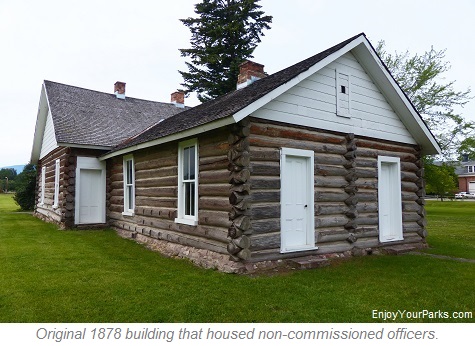 Built in 1877, Fort Missoula was originally established by the U.S. Army to protect pioneers settling in Western Montana as well as pioneers traveling on the Mullen Road from Native Americans threats.
Built in 1877, Fort Missoula was originally established by the U.S. Army to protect pioneers settling in Western Montana as well as pioneers traveling on the Mullen Road from Native Americans threats.
Built by the 7th Infantry, shortly after its construction, soldiers from Fort Missoula attacked the Nez Perce camp lead by Chief Joseph at the legendary Battle of the Big Hole, and were defeated. The second in command of Fort Missoula, Captain William Logan, was killed during this bloody battle. Later that year the third infantry, lead by General William Sherman then came in an expanded the fort and replaced the 7th Infantry, and also repaired 100 miles of the wagon train Mullen Road between Missoula and the Idaho border. Then in 1888, Fort Missoula became home to the famous Buffalo Soldiers of the 25th Infantry. Among many other things, the Buffalo Soldiers were known for experimenting with bicycles by creating a bicycle trail all the way to St. Louis, Missouri.
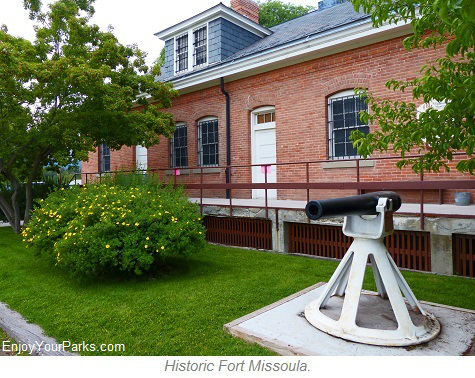 This bicycle trail has been revived in the city of Missoula, where residents and visitors alike can enjoy this historic pathway. During World War I, Fort Missoula was a military training facility. In 1933 Fort Missoula served as the administrative headquarters for the many Civilian Conservation Corps camps that were stationed in Montana, Glacier National Park, Yellowstone National Park and Northern Idaho until 1942. Fort Missoula then became a detention center for non-military Italian men that were merchant seamen, the crew of an Italian luxury liner seized in the Panama Canal, and World's Fair Employees. Known to the Italians as "Camp Bella Vista", 1,200 Italians were imprisoned here until their release in 1944. Once Pearl Harbor was bombed and the United States entered World War II following the bombing of Pearl Harbor, 650 Japanese-American men were "interned" here. Today, Fort Missoula is a popular place for history buffs to visit, as there are a large number of historic buildings and structures nicely preserved as well as a wonderful museum that is located at the fort and very much worth the time to explore.
This bicycle trail has been revived in the city of Missoula, where residents and visitors alike can enjoy this historic pathway. During World War I, Fort Missoula was a military training facility. In 1933 Fort Missoula served as the administrative headquarters for the many Civilian Conservation Corps camps that were stationed in Montana, Glacier National Park, Yellowstone National Park and Northern Idaho until 1942. Fort Missoula then became a detention center for non-military Italian men that were merchant seamen, the crew of an Italian luxury liner seized in the Panama Canal, and World's Fair Employees. Known to the Italians as "Camp Bella Vista", 1,200 Italians were imprisoned here until their release in 1944. Once Pearl Harbor was bombed and the United States entered World War II following the bombing of Pearl Harbor, 650 Japanese-American men were "interned" here. Today, Fort Missoula is a popular place for history buffs to visit, as there are a large number of historic buildings and structures nicely preserved as well as a wonderful museum that is located at the fort and very much worth the time to explore.
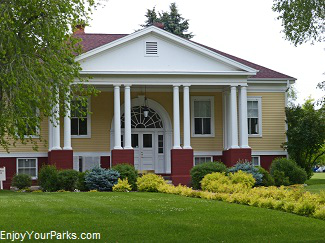

Fort Missoula Historic District, Missoula Montana
Smoke Jumper Base and Visitor Center
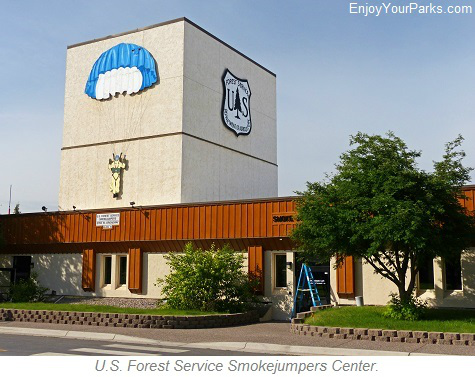 Missoula Montana is home to the largest smokejumper base in America, and the Smokejumper Visitor Center provides its visitors a fascinating interactive experience as they learn all about this important and dangerous profession.
Missoula Montana is home to the largest smokejumper base in America, and the Smokejumper Visitor Center provides its visitors a fascinating interactive experience as they learn all about this important and dangerous profession.
Free tours of the smokejumper facility include visits to the smokejumper loft, museum, 1930 fire lookout tower, Smokejumper Memorial and a Smokejumper aircraft.
If you're timing is good, you may even get to watch Smokejumpers actually dispatched to a forest fire!
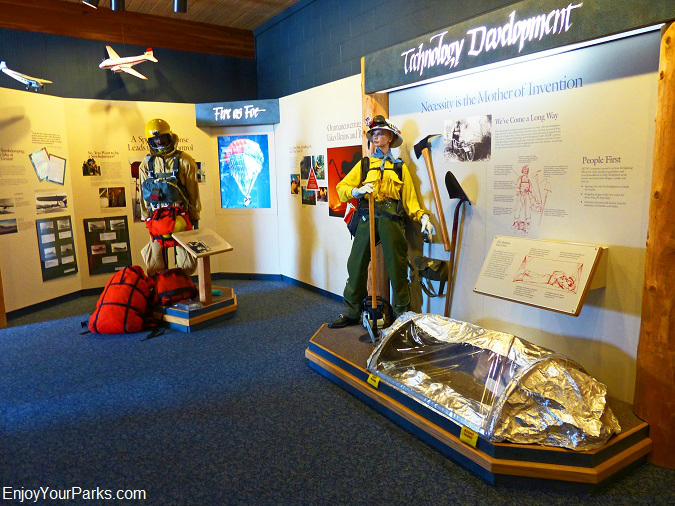
U.S. Forest Service Visitor Center, Missoula Montana.
Clark Fork River
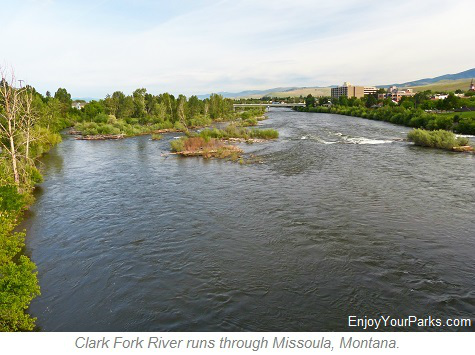 The Clark Fork River, also known as the Clark Fork of the Columbia River, flows 310 miles and is the largest river by volume in the State of Montana. Originating as Silver Bow Creek near Butte, Montana, and collecting water from the Anaconda Range and Pintler Range just beyond Butte, the Clark Fork River begins draining a huge region of the Rockies (nearly 26,000 square miles) as it flows northwest, collecting more and more water via tributaries such as the Bitterroot River, Little Blackfoot River, Blackfoot River, Flathead River and Thompson River.
The Clark Fork River, also known as the Clark Fork of the Columbia River, flows 310 miles and is the largest river by volume in the State of Montana. Originating as Silver Bow Creek near Butte, Montana, and collecting water from the Anaconda Range and Pintler Range just beyond Butte, the Clark Fork River begins draining a huge region of the Rockies (nearly 26,000 square miles) as it flows northwest, collecting more and more water via tributaries such as the Bitterroot River, Little Blackfoot River, Blackfoot River, Flathead River and Thompson River.
The Clark Fork River flows directly through the city of Missoula as it heads toward a long valley adjacent to the Cabinet Range of Northwest Montana before emptying into Idaho's Lake Pend Oreille. The Clark Fork River is an outdoor recreation enthusiast's dream come true as it provides outstanding fly fishing opportunities as well as white water rafting opportunities through what is known as the Alberton Gorge, located just west of Missoula.
Bitterroot Valley
 The City of Missoula basically marks the beginning of the north end of the magnificent Bitterroot Valley, which is a long, 90+ mile valley that runs north to south along the mighty Bitterroot Range.
The City of Missoula basically marks the beginning of the north end of the magnificent Bitterroot Valley, which is a long, 90+ mile valley that runs north to south along the mighty Bitterroot Range.
The broad Bitterroot Valley is home to the Bitterroot River, which is another fly fishing dream come true. U.S. Highway 93 runs through the Bitterroot Valley as well, which is dotted with several charming towns that each have their own unique and fascinating history as well as fun shops and attractions.
There is also one of the most important locations in the entire Lewis and Clark Expedition, as it is the only site along the entire journey that actually has physical proof of this historic 1804-1805 expedition. Click Here to learn more about the amazing Bitterroot Valley.
National Bison Range
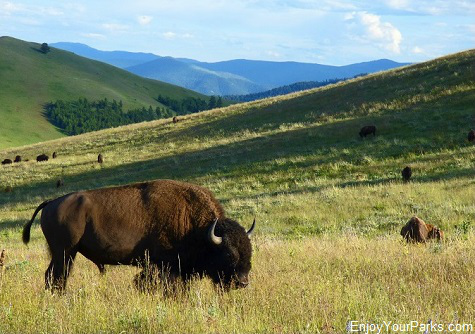 The National Bison Range is located near U.S. Highway 93, only 47 miles north of Missoula.
The National Bison Range is located near U.S. Highway 93, only 47 miles north of Missoula.
This wildlife refuge is home to about 500 buffalo (bison), as well as a host of other fascinating wildlife species. Created in 1908, the National Bison Range is one of the oldest wildlife refuges in the country, and not only is it a great place to see bison and other wildlife, but the scenery here is absolutely breathtaking.
CLICK HERE for more information on the National Bison Range located north of Missoula.
U.S. Highway 93 North Scenic Drive
 The 115 mile drive between Missoula and Kalispell Montana along U.S. Highway 93 North is not only the most popular route to Glacier National Park, but is also an incredibly scenic drive that deserves mentioning. Travelers will enjoy broad valleys and towering mountains, as well as Flathead Lake, which is the largest fresh water lake this side of the Mississippi River. Also along the route is a turnout to the National Bison Range, which is a popular destination for Montana tourists. Among the most notable landscapes along U.S. Highway 93 is the majestic Mission Mountain Range.
The 115 mile drive between Missoula and Kalispell Montana along U.S. Highway 93 North is not only the most popular route to Glacier National Park, but is also an incredibly scenic drive that deserves mentioning. Travelers will enjoy broad valleys and towering mountains, as well as Flathead Lake, which is the largest fresh water lake this side of the Mississippi River. Also along the route is a turnout to the National Bison Range, which is a popular destination for Montana tourists. Among the most notable landscapes along U.S. Highway 93 is the majestic Mission Mountain Range.
Beyond the junction to the National Bison Range, the highway will climb in elevation slightly just before it drops into the Mission Valley near St. Ignatius. At the highest point there is a scenic pullout that is very much worth your while. The Mission Range seems to touch the sky as it rises high above the valley floor. And once you drop into the Mission Valley, these amazing mountains loom over you to the east all the way to Flathead Lake. And don’t forget to stop at the historic St. Ignatius Mission along the way. Once U.S. Highway 93 reaches Flathead Lake at Polson Montana, it then follows the west shore of this massive lake as it works its way to Kalispell Montana. There are several scenic pullouts, marinas, wineries, state parks and charming towns such as Lakeside to enjoy along this scenic drive.
Flathead Lake
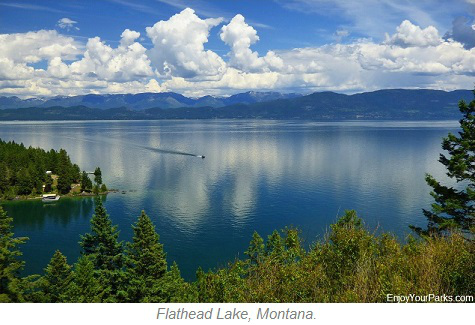 Flathead Lake is the largest freshwater lake in the United States other than the Great Lakes, and is 69 miles north of Missoula along U.S. Highway 93.
Flathead Lake is the largest freshwater lake in the United States other than the Great Lakes, and is 69 miles north of Missoula along U.S. Highway 93.
Not only does the highway drive through extremely scenic landscape, it takes you on of the most beautiful and pristine lakes found anywhere in North America.
Flathead Lake is renowned for its water sports and fishing opportunities, as well as the charming towns along its shores that provide wonderful shopping, lodging and dining. Beyond Flathead Lake, further to the north is the town of Kalispell and the West Entrance to Glacier National Park. CLICK HERE for more details about Flathead Lake and the surrounding area.




